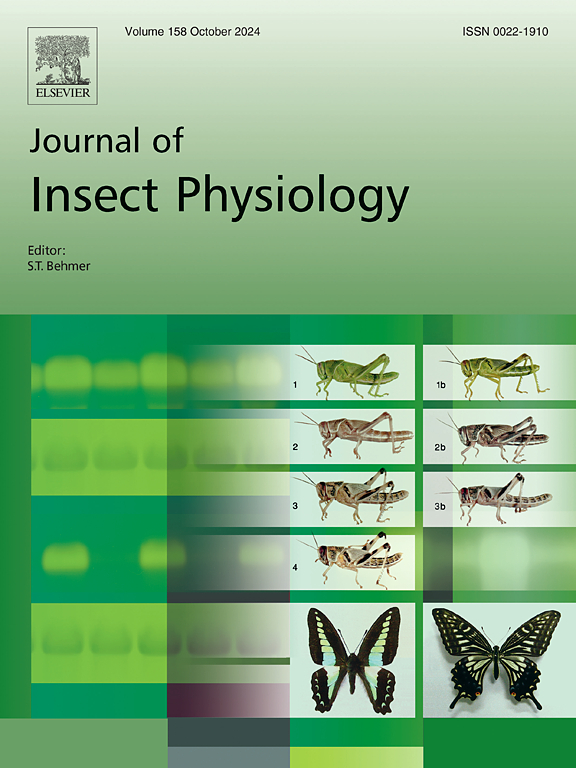Combined transcriptome and metabolome analyses provide insights into host adaptation mechanism of Spodoptera frugiperda to cruciferous vegetables
IF 2.3
2区 农林科学
Q1 ENTOMOLOGY
引用次数: 0
Abstract
The fall armyworm (FAW), Spodoptera frugiperda (J. E. Smith), is a worldwide migratory pest that inflicts considerable harm on numerous economically vital crops. Cruciferous vegetables, specifically pakchoi (Brassica campestris L.) and purple cabbage (Brassica oleracea L.), are prominent cash crops in southern China; nevertheless, the suitability of larvae for these crops remains undetermined. This study examined the performance of S. frugiperda when fed B. campestris and B. oleracea leaves. Histopathological investigation indicated no significant alteration in the structure of the larval midgut in the B. campestris treatment group; however the B. oleracea treatment adversely affected the larval midgut structure. The activities of GST, CarE, AMS, and LPS in larval midguts from various treatment groups were studied. Comparative transcriptome analysis revealed that 793 and 3375 differentially expressed genes (DEGs) were found in the samples treated with B. campestris and B. oleracea, respectively, in comparison to the control. The DEGs that encode detoxification and digesting enzymes were subjected to additional analysis. Metabolome analysis identified 295 and 241 differential metabolites (DEMs) in the samples treated with B. campestris and B. oleracea, respectively, in comparison to the control group. KEGG pathway enrichment analysis indicated that taste transduction and purine metabolism were significantly influenced by these two cruciferous vegetables. The comprehensive analysis of these two omics datasets revealed that the metabolic pathways of amino acids, carbohydrates, and lipids were collectively enriched with DEGs and DEMs. Our findings establish a basis for subsequent investigations into the fitness mechanisms of S. frugiperda on cruciferous vegetables.

结合转录组学和代谢组学分析,揭示了十字花科蔬菜中夜蛾对寄主的适应机制。
秋粘虫(FAW), Spodoptera frugiperda (J. E. Smith)是一种世界性的迁徙害虫,对许多经济上至关重要的作物造成相当大的危害。十字花科蔬菜,特别是小白菜(Brassica campestris L.)和紫甘蓝(Brassica oleracea L.)是中国南方重要的经济作物;然而,幼虫对这些作物的适宜性仍未确定。本研究考察了以油菜芽孢杆菌和甘蓝芽孢杆菌叶片为食的果树芽孢杆菌的生长性能。组织病理学检查显示,油菜芽孢杆菌处理组幼虫中肠结构无明显变化;然而,甘蓝处理对幼虫的中肠结构有不利影响。研究了不同处理组幼虫肠道中GST、CarE、AMS和LPS的活性。对比转录组分析显示,与对照相比,油菜芽孢杆菌和甘蓝芽孢杆菌处理的样品中分别存在793和3375个差异表达基因(deg)。编码解毒和消化酶的deg进行了额外的分析。代谢组学分析发现,与对照组相比,油菜芽孢杆菌和甘蓝芽孢杆菌处理的样品中分别有295种和241种差异代谢物(dem)。KEGG通路富集分析表明,这两种十字花科蔬菜显著影响了味觉转导和嘌呤代谢。对这两个组学数据集的综合分析表明,氨基酸、碳水化合物和脂质的代谢途径都富集了deg和dem。本研究结果为进一步研究frugiperda对十字花科蔬菜的适应性机制奠定了基础。
本文章由计算机程序翻译,如有差异,请以英文原文为准。
求助全文
约1分钟内获得全文
求助全文
来源期刊

Journal of insect physiology
生物-昆虫学
CiteScore
4.50
自引率
4.50%
发文量
77
审稿时长
57 days
期刊介绍:
All aspects of insect physiology are published in this journal which will also accept papers on the physiology of other arthropods, if the referees consider the work to be of general interest. The coverage includes endocrinology (in relation to moulting, reproduction and metabolism), pheromones, neurobiology (cellular, integrative and developmental), physiological pharmacology, nutrition (food selection, digestion and absorption), homeostasis, excretion, reproduction and behaviour. Papers covering functional genomics and molecular approaches to physiological problems will also be included. Communications on structure and applied entomology can be published if the subject matter has an explicit bearing on the physiology of arthropods. Review articles and novel method papers are also welcomed.
 求助内容:
求助内容: 应助结果提醒方式:
应助结果提醒方式:


